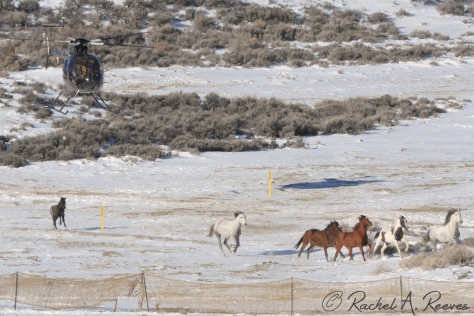This story seems like something from the 1800s. Since the 1970s, the federal government has balanced the rights of ranchers and railroads with those who enjoy the wild horse herds in the West. While there have been disputes on herd size and management, this story isn't about that. The Obama Administration’s policy is one that we find incredulous: U.S. policy is now aimed at zeroing out wild horse herd. It is one thing to manage them, but quite another to zero them out. While the focus of this article is on the Salt Wells group and the mistreatment that is currently underway, the White Mountain herd and the
Great Divide Basin herd are also scheduled to be eliminated.
This is a planned extinction event.This is something your grandchildren will not see.
The wild herds will be no more. Your grandchildren will never see them, only read about them. The man who claimed to heal the oceans has waged war on wild horses in America’s West.
It is bad enough that the herds are being zeroed out. The treatment of the animals in the Spring Hills facility is just another sad chapter to this ongoing tale of how these iconic animals of the west were lost.
Backdrop
Sandy Jewel, Secretary of the Interior, has decided to continue Ken Salazar’s policy to zero out these herds. The plan to do this is through capture, mass sterilization, and adopting out the “excess number.” Apparently, the whole herd is an excess number.
“The Secretary shall manage wild free-roaming horses and burros in a manner that is designed to achieve and maintain a thriving natural ecological balance on the public lands.”
I am not a lawyer, but I think zero is not the number intended by this act. “Thriving” implies a number greater than zero. Nevertheless, the Federal Court ruled that the BLM has the right to zero out these herds. Lloyd Eisenhauer, a former BLM manager in the Rock Springs was shocked by the court’s ruling in April of this year. He stated,
“The BLM has no biological or ecological basis for zeroing out a herd of wild horses in an HMA that existed at the time the wild horse statute was passed in 1971 . . . [B]ecause the wild horses have a statutory right to be there, whereas livestock only have a privilege that can be revoked at any time by BLM, there also is no authority or precedent, to my knowledge, for the agency to zero out these two longstanding wild horse herds simply to appease private livestock grazers.”
The court ruling stunned even those who were not opposed to herd reduction. Reducing the herd is one thing, but the court ruling has allowed the federal government to move forward with the zero herd policy. According to the BLM plan, the mares of the White Mountain herd were given fertility control treatment. The Salt Wells group was to be rounded up and shipped off. This effectively means that within 20 years, there will be no more wild horses.
It might be different if the people in the region were complaining about the horse. However, the only people really complaining is the Railroad and commercial scale operators were the motivation behind eliminating the herd. A reduction in wild herds is one thing to balance the interests of rangers and those with an interest in eco-tourism. That is vastly different from a zero out policy. The town of Adobe thrives on eco-tourism. People come to the small town of Adobe to see the horses. Sadly, the herd will no longer be there for future generations.
The Round-Up
Over Thanksgiving, the Bureau of Land Management (BLM) engaged in an aggressive mission to roundup Wyoming’s Salt Wells wild horses. The horses were rounded up by using helicopters to drive the horses in traps. Stallions were shipped 300 miles away to the Gunnison Prison Wild Horse program in central Utah. Rachel Reeves put together an extensive photo essay on that roundup.

Rachel Reeves has an
entire photo essay on the Thanksgiving roundup by the BLM.
Current Mistreatment
But the mares and foals were sent to the BLM’s Rock Springs corral. The facility does not have any wind break or shelter for the 668 captive horses. Eye witnesses in Rock Springs report the animals suffering in bitter cold and battering winds. In nature, they would have found shelter somewhere. In captivity, they are exposed to the elements and have no option to escape the brutal winds needed to survive. They are
suppose to be available for adoption, but first they have to survive until someone steps up to the plate and adopts them.
“Mares and foals seemed frozen in place, resigned, unmoving. There is no shelter for these horses in Short Term Holding Facilities and although they have heavy winter coats, these horses have nowhere to get out of the biting, stinging wind. In their natural setting, they would be out of sight in low areas, gullies, next to cliffs, sheltered from the wind.”
You’d think someone would zip tie some concrete blankets along the corral to block the wind. In the wild, these horses would be in forested areas where the trees or in rocky enclaves to break the wind. They would not be out in the open. Sadly, in a corral, the don’t have much of a choice. Horse owners will quickly notice the lack of hay and water available in the corral.
A requirement for adopting a horse is for the prospective owner to show
they have a 3 sided shelter. Yet it appears from Walker’s photos that the BLM does not provide such a shelter for the horses in their custody.


Finally, some hay.

The group has a
Facebook page if anyone wants to stay up to date on the status of the horses. Those interested in adopting a horse can find additional details on the
BLM website.












































